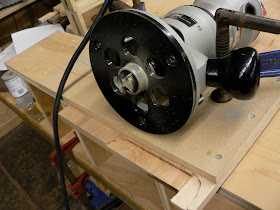I’m Jim Dillon. I work at Fernbank Science Center in
Atlanta as a cabinetmaker. I build and repair exhibits,
cabinetry, and teaching aids there. I teach occasional
woodworking classes at Highland Woodworking. I have also
been a freelance writer, a college English teacher, and a
warehouseman.
A list of the trades I’ve worked at doesn’t really add up
to an answer to the question “Who am I?” But perhaps if
you read more of what’s here, and I write it well enough,
you’ll figure me out. For now, let’s assume that since I work
wood, teach people how to work wood, and explain stuff
on a professional level, I’m qualified to write a blog about
woodworking.
Why am I here? More to the point, why am I writing this
blog and why should you read it?
I call this blog “The Thousand-Dollar Shop” because I want
to encourage you to just buy a few basic tools and get
going. If you inventory the stuff you see and hear about
in here, it’ll be obvious that I have more than a thousand
dollars invested in my gear. But it certainly didn’t come in
one lump. I’ve gradually picked up this and that as I needed
it. As of today I’ve been accumulating woodworking tools for
about 25 years, and I won’t try to hide that from you. But
I am absolutely sure that if you can scrounge up a circular
saw, a drill, a few clamps, a pocket hole jig, and some
sandpaper and glue, you can make yourself a perfectly fine
bookcase.
DO IT! If you’ve been thinking it would be cool to make this
or that for yourself, but you’re intimidated by all the gear
you see in those shops on tv, or by all the skills you hear the
preening website experts bragging about, listen to me: you
can make perfectly fine stuff without all that. Try a project
or two, start small, and build from there. It works! It’s what
I did when I graduated from college and wanted a bookcase
and saw I couldn’t afford a good one.
That’s why I’m here: to encourage you to have a try at it.
And to show you how to do it without going into debt. And to
show you how much fun it is.
2010-11-25
2010-10-23
With Benefits
Hi,
One of the cool things about being a woodworker is that you get to see wood in ways most people never do get to see it. Perhaps the classic example is eastern red cedar, which when freshly planed is a gorgeous pink shade of purple. Within a few days, it fades to the reddish brown most people are familiar with.The other day I was prepping some stock for my dovetails by hand class at Highland Woodworking. I like to use yellow poplar in these classes, because it's not expensive or fancy, so nobody's nervous about "wasting" "expensive" wood just for learning. It's also, usually, a vaguely greenish shade of yellow when freshly milled, and turns caramelly brown over time.
This batch of wood, though, had been put into the kiln without any initial air drying, and so things stayed pretty wet in the kiln for the first part of the cycle. The fungus had some fun with this stuff. I planed through some black gunk on the outside of the planks, and lo, the interior of the wood had some gorgeous red and purple staining, here and there, like cranberry clouds in a chartreuse sky on the cover of a science fiction paperback from the 1960's. Like this:
Unfortunately, this is just fugitive color in a few random pieces of lumber. Not enough to design a project around, and probably nothing that would remain visible for any length of time. Just another unquantifiable benefit you get as a woodworker.

